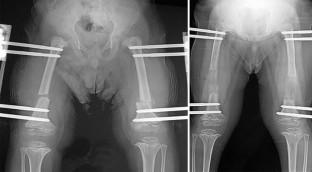Indian Journal of Orthopaedics ( IF 1 ) Pub Date : 2022-07-16 , DOI: 10.1007/s43465-022-00694-5 Serkan Bayram 1, 2 , Ahmet Müçteba Yıldırım 1 , Levent Eralp 1 , Cengiz Şen 1 , Mehmet Kocaoğlu 3 , Halil İbrahim Balci 1

|
Objectives
This study investigated the effect of the femur, tibia, and humeral lengthening rate in patients with achondroplasia and regenerated bone quality.
Methods
The records of the patients with achondroplasia who underwent limb lengthening surgery for both upper and lower extremities between 2002 and 2019 were retrospectively reviewed. Bone formation regeneration was evaluated in each segment at anteroposterior and lateral radiographs and the callus quality was determined at the first month of the consolidation period according to Li’s classification system.
Results
This study included 42 (28 females and 14 males), 38 (26 females and 12 males), and 17 (11 females and 6 males) patients with bilateral femoral, bilateral tibial, and bilateral humeral lengthening. The mean lengthening rate was 0.920 ± 0.23 (range, 0.53–1.67), 0.813 ± 0.17 (range, 0.51–1.26), and 1.02 ± 0.26 (range, 0.58–150) mm/day in the femoral, tibial, humeral groups, respectively. In the femoral group, 75% femur with good morphological quality, 56.6% good morphological quality in tibial group and 55.9% good morphological quality in humeral group. Statistically significant relationships were found between femoral lengthening rate and callus quality (p < 0.001; r = 0.454). However, no significant correlation was found in the humeral and tibial groups. Moreover, the sensitivity and specificity of the lengthening rate for obtaining good morphological quality callus were 72% and 80%, respectively, with an optimum diagnostic cutoff value of 0.976 mm/day for femoral lengthening.
Conclusions
A higher-rate good morphological callus was obtained in femoral lengthening compared with tibia and humerus in patients with achondroplasia.
中文翻译:

软骨发育不全患者肢体延长率与愈伤组织质量的关系
目标
本研究调查了股骨、胫骨和肱骨延长率对软骨发育不全患者和再生骨质量的影响。
方法
回顾性分析2002年至2019年接受上下肢延长手术的软骨发育不全患者的记录。在前后位和侧位X线片上评估每个节段的骨形成再生情况,并根据Li的分类系统在巩固期的第一个月确定骨痂质量。
结果
这项研究包括 42 名(28 名女性和 14 名男性)、38 名(26 名女性和 12 名男性)和 17 名(11 名女性和 6 名男性)接受双侧股骨、双侧胫骨和双侧肱骨延长的患者。股骨、胫骨、肱骨组的平均延长率为 0.920 ± 0.23(范围,0.53–1.67)、0.813 ± 0.17(范围,0.51–1.26)和 1.02 ± 0.26(范围,0.58–150)mm/天。分别。股骨组中,股骨形态质量良好的比例为75%,胫骨组形态质量良好的比例为56.6%,肱骨组形态质量良好的比例为55.9%。股骨延长率和骨痂质量之间存在统计学显着关系(p < 0.001;r = 0.454)。然而,在肱骨和胫骨组中没有发现显着相关性。此外,获得良好形态质量愈伤组织的延长率的敏感性和特异性分别为72%和80%,股骨延长的最佳诊断临界值为0.976毫米/天。
结论
与软骨发育不全患者的胫骨和肱骨相比,股骨延长获得了更高比例的良好形态愈伤组织。



























 京公网安备 11010802027423号
京公网安备 11010802027423号